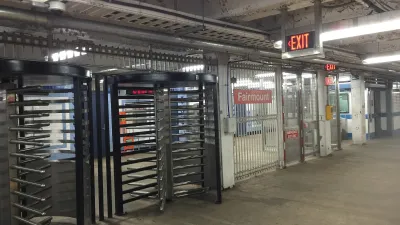Inga Saffron asks the tough questions of Philadelphia's sale of University City High School to Drexel University.
Philadelphia Inquirer architecture critic Inga Saffron has strong words about the potential implications of the recent sale of University City High School to Drexel University: "Goodness knows, Philadelphia's school district needs to sell its surplus buildings so it can afford to open its remaining schools in the fall, ideally with a full complement of nurses and counselors. But should its money troubles trump everything else the city wants to achieve: livable neighborhoods, affordable housing, pedestrian-friendly design, meaningful open space, a respect for its own history?"
"Nothing highlights the harsh reality of this single-minded quest for cash as much as this week's battle royal over the sale of the University City High School on Drexel University's western border. Sitting on 14 acres of land, it's the most valuable property in the district's sales portfolio, and one of the largest sites. Based on their push to fast-track approvals, Mayor Nutter and City Council President Darrell L. Clarke see only dollar signs when they look at that dour '70s-era fortress."
The problem with the sale, according to Saffron, is that no planning process guided the sale of the site, already a result of the negative consequences of "urban renewal" efforts of the late 1960s: "Because the city has been taking a relentlessly transactional approach to policy-making lately, the site was put up for sale as though it were nothing more than a used car. Little thought was given to the best use for that publicly owned site: There were no planning studies done, no goals articulated, no guidelines established."
For more details on Drexel's proposed $1 billion redevelopment of the site (Drexel and partner developer James R. Berens' Wexford Science & Technology LLC paid $25.15 million for the 14-acre site), see another article by Joseph N. DiStefano.
FULL STORY: Changing Skyline: City ought not rush into sale of school buildings

Trump Administration Could Effectively End Housing Voucher Program
Federal officials are eyeing major cuts to the Section 8 program that helps millions of low-income households pay rent.

Planetizen Federal Action Tracker
A weekly monitor of how Trump’s orders and actions are impacting planners and planning in America.

Ken Jennings Launches Transit Web Series
The Jeopardy champ wants you to ride public transit.

New Mexico Aging Department Commits to Helping Seniors Age ‘In Place’ and ‘Autonomously’ in New Draft Plan
As New Mexico’s population of seniors continues to grow, the state’s aging department is proposing expanded initiatives to help seniors maintain their autonomy while also supporting family caregivers.

USDOT Waters Down Self-Driving Car Regulations
The agency is reducing reporting requirements for autonomous vehicles and cars with self-driving features, prompting concern among safety advocates who say transparency is essential to the safe deployment of AV technology.

‘Minnesota Nice’ Isn’t so Nice When You Can’t Find a Place to Live
The Economic Development and Housing Challenge Program can help address the scourge of homelessness among Indigenous people.
Urban Design for Planners 1: Software Tools
This six-course series explores essential urban design concepts using open source software and equips planners with the tools they need to participate fully in the urban design process.
Planning for Universal Design
Learn the tools for implementing Universal Design in planning regulations.
Heyer Gruel & Associates PA
Ada County Highway District
Institute for Housing and Urban Development Studies (IHS)
City of Grandview
Harvard GSD Executive Education
Toledo-Lucas County Plan Commissions
Salt Lake City
NYU Wagner Graduate School of Public Service




























